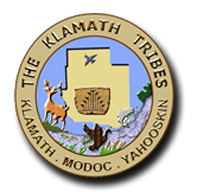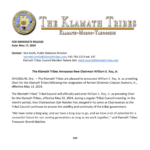CHILOQUIN, Ore. — Don Gentry stood under a pine tree on a late summer day overlooking the confluence of the Williamson River and Spring Creek.
“We’re at the headwaters of the Klamath River, the spring creek that flows out of the ground up there,” said Gentry, pointing at the burbling waters that feed Upper Klamath Lake and eventually, the Klamath River.
Gentry is the former chairman of the Klamath Tribes, who have been working to reclaim their reservation lands and waters in the Upper Klamath River Basin. They’re also trying to preserve the two fish species at the heart of their cultures.
The Klamath Tribes, the only tribe on the river holding a ratified treaty with the U.S., has a long relationship with Upper Klamath Lake and the Upper Klamath Basin. They own the most senior water rights in southern Oregon, and they’re not afraid to use those rights to address their issues with fish in their traditional lands. That has put them at odds with farmers who also rely on the river to grow potatoes, onions and other crops after the U.S. government invited them to homestead in the now-drained Lower Klamath and Tule lakes.
The three cultures of the Klamath Tribes — the Klamath, Modoc and Yahooskin Paiute — have inhabited southern Oregon, the Tule, Upper Klamath and Clear lakes and the lands around what is now Lava Rocks National Monument for millennia. Gentry said anthropologists confirm they have lived and worked in the basin for at least 15,000 years.
In 1864, the Klamath ceded 23 million acres to the U.S., receiving a 1.8-million acre reservation in southern Oregon. They retained the right to hunt, fish and gather plants.
The tribe enjoyed prosperity, thanks to its logging and cattle operations. Tribal members also continued to hunt and fish for salmon, steelhead and the fish they are culturally affiliated with: the c’waam, or Lost River sucker and the koptu, or shortnose sucker. Those fish once inhabited both Upper and Lower Klamath lakes and the Lost River watershed.
The c’waam is at the center of Klamath culture, according to Klamath Tribes Chairman Clayton Dumont.
“Gmok’am’c, the Creator, chopped up a serpent who tormented the people,” Dumont said. “He changed the pieces into the c’waam and told the people to care for the fish and the fish would take care of them.” The tribe has worked to care for those fish ever since.
With their prosperity, the tribe confronted ancient ethics regarding how they used the land’s bounty.
“We’re not preservationists; we use things,” Gentry said. But the land’s blessings come with responsibilities. “As humans, we have a real responsibility to only take what we need,” he said. For example, “We would gather duck and goose eggs but we wouldn’t take them all.” Those ethics and morals have survived colonization.
But the massive system of lakes, marshes, rivers and streams once known as the “Everglades of the West” that had sustained fish, birds, other wildlife and Native peoples would be altered to suit settler priorities.





